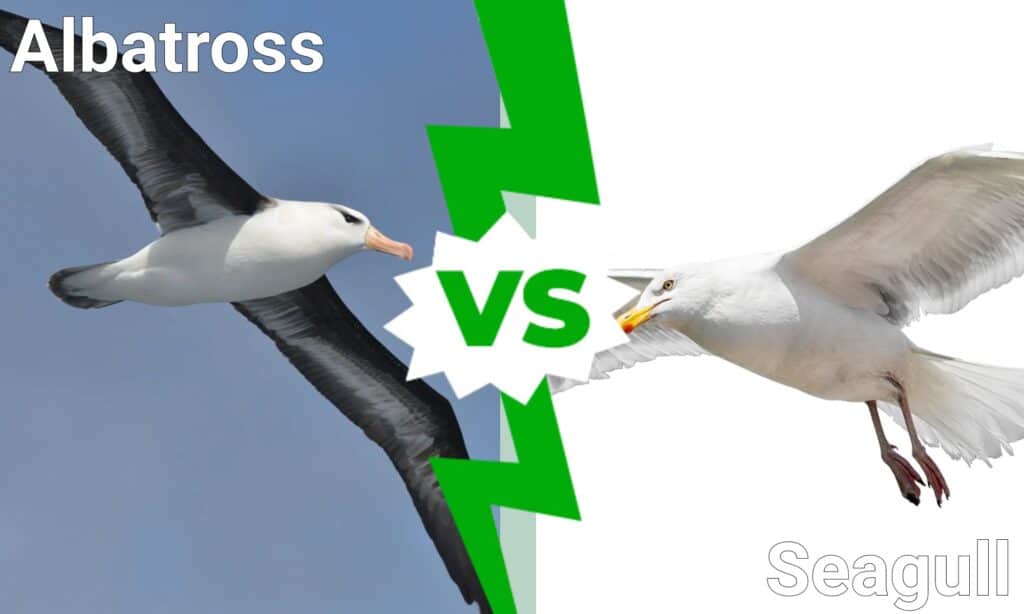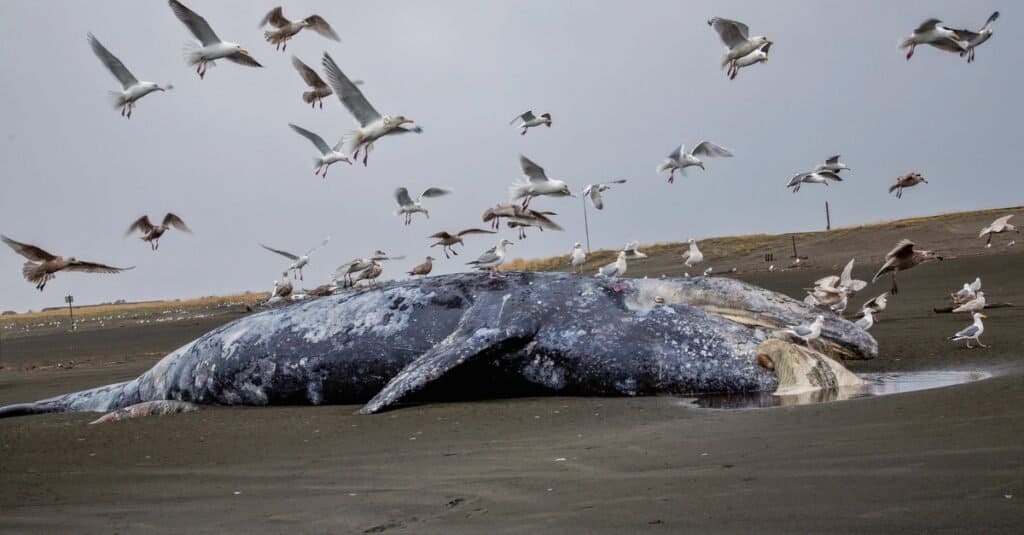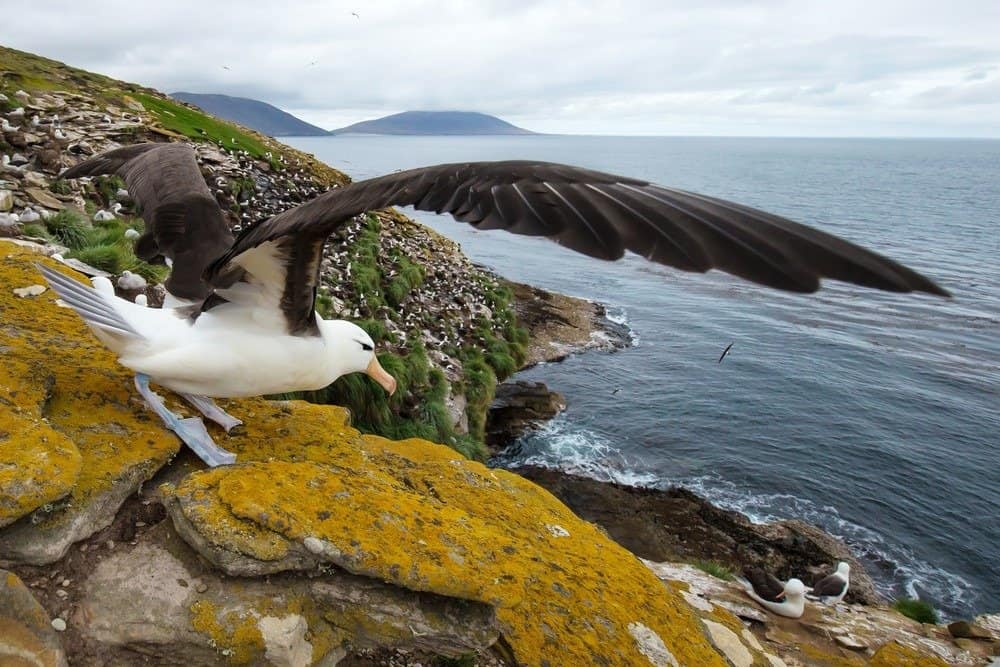The albatross and the seagull are impressive seabirds that share a love of the open ocean. The albatross is a legendary creature and the feature of The Rime of the Ancient Mariner by Samuel Coleridge. Within this poem, an albatross appears in order to lead a ship to safety. After it does, a mariner shoots it. As punishment, he must wear the albatross around his neck. Therefore, when someone is facing a great burden, they’re said to have “an albatross around the neck.” Seagulls are counted among the most intelligent birds in the world. Some will drop a mollusk shell upon a rock to reach the contents inside, others bait fish with bread. New foraging strategies are passed down through gull generations. But what are the differences between the albatross and the seagull?
Let’s take a deeper look at albatross vs seagull and see how these beachbound birds differ.
Comparing an Albatross and a Seagull

| Albatross | Seagull | |
| Scientific Classification | Order: Procellariiformes, Family: Diomedeidae | Order: Charadriiformes, Family: Laridae |
| Range | Southern Hemisphere, parts of North Pacific | Worldwide |
| Habitat | Marine, Islands | Marine, freshwater, inland |
| Size | up to 22 lbs | 4 oz – 4 lbs |
| Wingspan | 6.5 – 11 feet | 2 – 5 feet |
| Diet | Carnivorous | Omnivorous |
| Lifespan | Up to 50 years | Up to 20 years |
| Nest | High nest | Ground nest |
| Clutch Size | 1 egg | 3 eggs |
The Key Differences Between Albatross and Seagulls
The main differences between albatross and seagulls are their scientific classification, range, habitat, size, wingspan, diet, lifespan and nest type and clutch size. While the former belongs the Diomedeidae family, the seagull belongs to the Laridae family. Albatross are largely carnivores whereas seagulls are omnivores. Besides albatross have a larger wingspan and weigh more than seagulls.
Let’s explore the differences in detail below.
Scientific Classification

utch size.
©iStock.com/Evgenyi_Eg
The name albatross refers to any member of the family Diomedeidae. These are large, web-footed seabirds with incredibly long and slender wings. This scientific name is derived from the Greek hero Diomedes, in reference to the myth of his men being turned into swan-like birds. The albatross belongs to the order of Procellariiformes along with petrels, shearwaters and other seabirds. Albatross are one of the most threatened bird species on earth. Out of 21 albatross species 19 are threatened or endangered. The Chatham albatross is considered critically endangered with a population of 11,000 birds.
On the other hand, seagulls, or gulls, are seabirds in the Laridae family. They’re part of the Charadriiformes order, which includes waders, gulls and auks. Furthermore, seagulls fall within the Lari suborder along with terns, skuas and skimmers, as well as waders and snipes. There are over 50 species of gulls. Some have populations in decline and are considered vulnerable or near-threatened.
Albatross vs Seagull: Habitat and Range
Albatross are native to the Southern Hemisphere around Antarctica, South America, South Africa and Australia. Some species live throughout the North Pacific as well. Adapted to long, soaring flight they can cover large distances over the ocean without ever flapping their wings. Surprisingly, they can spend the first six or so years of their long lives without ever touching land. Albatross require strong winds for their journeys. They may struggle in areas where there are gaps in the wind.
Seagulls breed on every continent but are somewhat less common on tropical islands. Within their appropriate habitats, they exist worldwide. Species exhibit great variation in their preferences and inhabit marine, freshwater and inland habitats. The majority make a home of coastal habitats. Notably, most gulls are migratory and move either large or short distances to warmer climates, depending on their species.
Diet of Albatross vs Seagull

The albatross is carnivorous, while the seagull is an omnivorous feeder.
©Bob Pool/Shutterstock.com
The albatross diet is carnivorous, consisting mainly of squid, fish and krill. They’re fond of offal (organ meat) and sometimes scavenge carrion or feed on zooplankton. These seabirds are only able to dive into the top few feet of the ocean for their catch. If they see prey in flight, some species can plunge rapidly to catch it. Their diet varies by species and is dependent on local habitat. For example, some catch mostly squid, while others rely on fish. They’re crafty feeders and will sometimes trail behind ships to consume their leftovers or feast on floating carrion.
While most birds use eyesight to locate and capture prey, albatross use their well-developed sense of smell to find their food. Like many seabirds, they’re able to drink both salt and freshwater. Special glands allow them to excrete salt through their nostrils. This allows the kidneys to maintain proper electrolyte balance.
However, seagulls are opportunistic feeders; they omnivores that can take advantage of a wide range of prey. Overall, they eat fish, insects, worms, rodents, eggs, carrion and offal, as well as reptiles and amphibians. They also eat some plants, seeds and fruit and often scavenge through leftovers from humans.
As generalists, gulls are better adapted to walking on land than many seabirds. They’ll prowl the same scavenging site day after day if it’s productive. They’ll fly high in the air and dive down to capture prey, but like the albatross, are not capable of diving deep down below water. Another feature in common with albatross, seagulls can process seawater with salt glands. They have grooves in their bills that let the salty liquid drip down. These birds will often be seen shaking their heads and sending the briny solution back to sea.
Albatross vs Seagull: Appearance

The albatross has a wingspan of up to 11 feet while seagulls’ wings are 2-5 feet wide.
©Giedriius/Shutterstock.com
Albatross are very large birds with varied coloration of white, black and grey. They possess a strong, sharp-edged and hooked bill. This long bill is typically orange or yellow and made of horny plates. Along its sides are tubes that allow albatross to measure their airspeed in flight. This is necessary for their incredible soaring feats. These birds have an astounding wingspan of around 6.5 feet up to about 11 feet. The wingspan of the royal albatross and the wandering albatross has exceeded 11 feet from tip to tip. This is the largest wingspan of any bird in the world. Albatross can weigh up to 22 pounds.
Seagulls have heavy bodies and long legs. Their yellow, red or black bills are stout and end in a hook. Overall, their plumage is white with darker back feathers. Some species vary and are entirely white, grey or black. The wingtips of most species are black. Head color varies by species and by breeding season. Seagulls have a varied wingspan from about 2 feet to over 5 feet. They can weigh from 4 ounces up to 4 pounds.
Albatross vs Seagull: Mating & Reproduction
Albatross migrate to coastal areas for breeding after months at sea. They’re very careful when choosing a mate. They can live up to 50 years and mate for life. These birds engage in elaborate song and dance rituals accompanied by preening, bill contact, calling and pointing. Albatross mates incubate the egg, construct the nest and raise the young together. They’re colonial and build nests nearby others, often on isolated islands. They build high nests of grass, soil, shrubs and feathers.
Typically, albatross only produce one egg per breeding season. This hatched chick is highly dependent with a lengthy chickhood in response to an inconsistent food supply. A chick that’s slow to mature needs food less often than one that’s growing fast. The parents share food gathering and protection duties, feeding the chick a mixture of krill, fish, squid and an oily substance produced in their stomachs from digested prey.
Seagulls have their own courting practices with the males often performing mating dances or other rituals. Seagulls can live up to 20 years and once a pair is established they’re generally paired for life. At times, separation does happen, but it comes at social cost. They are colonial birds who settle into large groups, with pairs having their own nests. Traditional nest sites are sea-cliffs, sand dunes, islands off the coast and inaccessible locations inland. Nests are often made on the ground, but sometimes built up high. Constructing them of twigs and grasses is part of pair bonding. Usually, both parents incubate and feed the young. They typically have a clutch of 3 eggs.
The photo featured at the top of this post is © MZPHOTO.CZ/Shutterstock.com
Thank you for reading! Have some feedback for us? Contact the AZ Animals editorial team.






